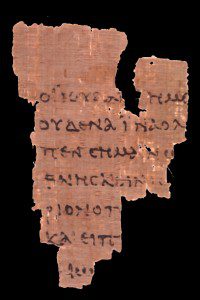Yes, according to Dr. Daniel Wallace. He has recently revealed what he believes to be a manuscript of the Gospel of Mark that comes from the first century A.D.
Wallace is a professor of New Testament at Dallas Theological Seminary and the founder of The Center for the Study of the New Testament Manuscripts, an institute that seeks to study and preserve the manuscripts of the New Testament. Wallace is an expert in biblical Greek and in textual criticism, the academic study of ancient manuscripts.
A couple of weeks ago, Wallace was debating Bart Ehrman, another biblical scholar known widely for his negative writings about historical Christianity. Their topic was whether or not we have the wording of the original New Testament today. In this debate, Wallace referred to the discovery of seven New Testament papyri (a primitive form of paper). Six of these are from the second century. One is probably from the first century. The alleged first-century manuscript is a fragment of the Gospel of Mark, though we don’t know what part of the text it contains.

According to Wallace, this manuscript “was dated by one of the world’s leading paleographers,” who said he was “certain” that it was from the first century. If that paleographer is right, then this fragment would be the oldest existing manuscript of the New Testament. Until now, the oldest manuscript we have is p52 (Papyrus 52), a small portion of the Gospel of John that is dated to the first half of the second century.
Until now, the oldest existing manuscript of Mark’s Gospel is p45, which was copied around 200 A.D. Though scholars believe that this manuscript faithfully reproduces most of what was in the autograph (original copy) of Mark, the new fragment would offer fresh and powerful evidence for or against this thesis. According to Wallace, the newly discovered fragment confirms what text critical scholars believe to be the authentic text of Mark. In other words, the fragment supports scholarly confidence that we have access to almost everything originally written by the author of Mark.
Unfortunately, however, the new fragment has not been published. Apparently, it will be published by Brill in a year or so. Wallace is not free to discuss the details of the text. So we have no way to evaluate his claims, apart from our sense of Wallace’s own trustworthiness.
New Testament scholar Larry Hurtado adds a little more information about the source of the new manuscript in his blog:
The fragment in question seems to be part of a collection of papyri that are part of the Green Collection (http://explorepassages.com/collection). The key figure listed as the guiding expert for the Greek Collection is Scott Carroll. One of the recent postings lists putative early fragments of several NT writings (including copies of some Pauline letters allegedly dated to the second century CE). According to Wallace, a formal scholarly publication of these items is in the works, scheduled to appear next year sometime.
How should we respond to the claims made by Daniel Wallace?
First of all, Daniel Wallace is a trustworthy NT scholar and an expert in text criticism. I trust what he says. So I believe there is a fragment of Mark that a highly-regarded paleographer has dated to the first-century A.D.
The dating of the fragment, however, will be controversial. Paleographical dating is imprecise. I guarantee that some scholars will date it to the second century or maybe later.
The discovery of this fragment of Mark could undermine significantly our confidence that we know what was in the original edition of Mark if it differs considerably from the texts we have now. According to Wallace, this is not the case. If he is correct, then this discovery will strengthen our confidence in the text of the New Testament. The manuscripts we have allow us to know, with a very high degree of probability, what the text of the New Testament originally contained.
Yet, even the most skeptical of scholars acknowledge the basic reliability of the text of the New Testament. Bart Ehrman, for example, who tries to argue that we should not have confidence in the text, has nevertheless written things like:
To be sure, of all the hundreds of thousands of textual changes found among our manuscripts, most of them are completely insignificant, immaterial, and of no real importance for anything other than showing that scribes could not spell or keep focused any better than the rest of us.
Ehrman also points out that no significant doctrine of Christianity depends on insecure manuscript evidence.
So, if we do have a first-century fragment of Mark, we will have a slightly stronger argument for the authenticity of the text of the New Testament. This will be helpful, but will not significantly impact our faith. It will make it harder for extreme skeptics, like Bart Ehrman, to defend their point of view.















